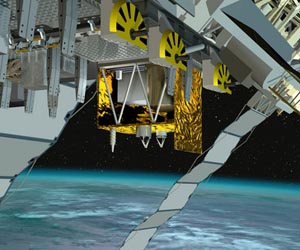 The ACES mission will improve the accuracy of time measurement and therefore enable the analysis of the predictions of the theory of relativity with a higher resolution of up to two orders of magnitude compared to current experiments. |
Friedrichshafen, Germany (SPX) Jul 21, 2010
Alain Charmeau, CEO of Astrium Space Transportation, Michael Menking, Director of Orbital Systems at Astrium Space Transportation and Simonetta di Pippo, ESA Director for Human Space Flight, have signed a euros 35M contract for the full development of the Atomic Clock Ensemble in Space (ACES) for the International Space Station (ISS).
This contract follows on from several years of pre-development under the prime contractorship of Astrium.
The contract comprises the development of the ACES Flight Model, up to its integration for launch on the Japanese HTV transport vehicle. Additionally it includes the set-up of the ACES specific ground segment, establishing a network of ground reference clocks, communicating with the ISS based ACES payload and its two atomic clocks via Microwave-Link ground terminals.
The ACES payload will test a new generation of atomic clocks in space. The Caesium cold atom clock PHARAO, developed and provided by CNES, and the Space Hydrogen Maser (SHM), funded through the Swiss contribution to ELIPS( European Life and Physical Sciences (Program), are the heart of the ACES payload.
They will be characterised and compared to each other, as well as to ground based national time standards in different countries.
The fact that time and frequency can be measured very precisely, far better than any other physical parameter, is basic for physical measurements on relativistic effects.
The ACES mission will improve the accuracy of time measurement and therefore enable the analysis of the predictions of the theory of relativity with a higher resolution of up to two orders of magnitude compared to current experiments.
This can be achieved by the manipulation of cold atoms under microgravity conditions, allowing longer interaction between the atoms and the laser radiation, because the perturbation from the Earth's gravitational force is removed.
In the research community the ACES is considered to be one of the most exciting microgravity physics experiments on the ISS ever conceived, and therefore the ACES project is accredited with the highest scientific merits.
The ultimate performance of space based atomic clocks in a microgravity environment will be explored and a number of fundamental physics experiments will be performed. A number of ground based atomic clocks, at research institutes world-wide will also participate in the ACES mission.
Delivery of the ACES Payload for launch to the ISS is planned for autumn 2013 with an on-orbit accommodation on the Columbus External Payload Facility (CEPF). The duration of the mission will be at least two years.
www.space-travel.com
No comments:
Post a Comment